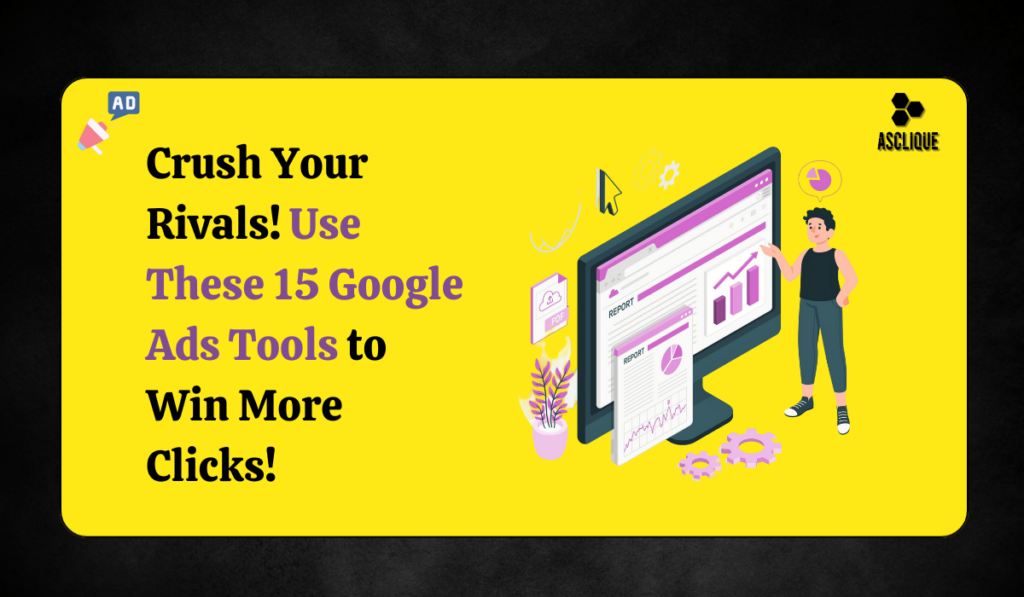To execute a Google Ads campaign without keeping an eye on your competitors is to compete blindfolded. If you want to stay ahead, you have to be aware of what your competitors are doing—what keywords they are using, how much they are investing, and what kind of ads they create. This is where Google Ads competitor analysis tools are useful. They assist you in tracking competitor ads, discovering high-performing keywords, analyzing spending habits, and optimizing your PPC strategy for improved ROI.
With the appropriate tools, you can learn what works and what does not work in your niche. You can then use that information to tweak your ad strategy, reduce wasteful expenditure, and increase conversions.
In this post, we’ll take a closer look at 15 of the top Google Ads competitor analysis tools that can give you an advertising advantage.
Why Google Ads Competitor Analysis Tools?
Let’s begin by looking at why the tools are critical to marketers:
Keyword Discovery
- One of the most notable advantages of competitor analysis using Google Ads is discovering high-value keywords. By using these tools, you can identify which keywords your competitors are bidding on and then target profitable search terms that will drive quality traffic to your website.
Ad Copy Insights
- A well-written ad copy can greatly influence click-through rates. Looking at competitor ads, you can find trends in messaging, promotions, and calls to action that appeal to your target audience. This enables you to optimize your own ad copy for greater engagement.
Budget Estimation
- Knowledge of how much your competitors are advertising on Google Ads provides you with a baseline for the setting of your budget. Some tools offer estimated ad spend, and this will assist in planning and resource allocation without breaking the bank.
Performance Benchmarking
- Benchmarks against competitors can identify areas of improvement. Impression share, ad rank, and click-through rates enable you to refine your bidding strategies and ensure campaign optimization.
Landing Page Analysis
- Effective ads don’t only use keywords and ad copy—they also rely on high-converting landing pages. A competitor analysis tool can help identify two things: the various types of landing pages the competitors have built and which landing pages have been proven to be successful.
Tracking Advertisements
- Google Display Network ads usually have a wider reach, and knowing what banner ads competitors are using would provide some insight into their visual tactics in advertising. Certain tools enable you to monitor competitor display ads, which will help you refine your visual creatives.
Better ROI
- Learning from competitors’ success and failure, you can save money on avoidable mistakes and fine-tune your ad campaigns for improved return on investment.
Now let us wander through our 15 free tools that would assist you in analyzing Google Ads competitors.

SEMrush – Ideal for Comprehensive PPC Study
SEMrush is an absolute powerhouse among Google Ads competitor analysis tools as it provides soul-deep insights on paid advertisements and their performance.
Key Features:
- Find competitor PPC keywords
- Analyze ad copies and history
- Estimate ad spend of competitors
- Monitor Google Shopping Ads
Why Use SEMrush?
SEMrush provides you with detailed information regarding your competitors’ Google Ad campaigns. It helps you to track keyword ranks, ad history, as well as budget estimates. It is particularly impressive because it can analyze Shopping Ads, making it an ideal solution for e-Commerce stores.
If you need a comprehensive tool for keyword research, ad tracking, and benchmarking performance, SEMrush is a good investment.
SpyFu – Ideal for Competitor Keyword Insights
SpyFu is all about revealing your competitors’ PPC and SEO plans. It shows profitable keywords and ad spending information.
Key Features:
- View all keywords competitors bid on
- Monitor competitors’ ad history
- Watch PPC budget trends
- Analyze competitor landing pages
Why Use SpyFu?
SpyFu is great for companies that need a comprehensive breakdown of their competitors’ Google Ads plan. It displays historical ad performance, which allows you to view which keywords have performed well consistently over the long term.
For advertisers who need to create a successful PPC strategy, SpyFu is an absolute necessity.
Ahrefs – Most Suitable for Expert Keyword & PPC Monitoring
Ahrefs is well recognized in SEO, yet it also gives valuable Google Ads competitor analysis instruments for PPC investigations.
Key Features:
- Paid Keyword Rankings Monitoring
- Find Out the Most Successful PPC Advertisements
- Estimates of CPC and Competition Metrics
Why Choose Ahrefs?
Ahrefs has a simple user interface with organic and paid search data. Companies that are looking for an all-in-one tool to be used for both SEO and PPC information may also be interested in Ahrefs.
Google Ads Auction Insights (Google Free Tool)
Auction Insights for Google Ads is a free feature of Google Ads that allows users to compare the performance of their campaigns against competitors.
Some Key Features:
- Analyze impression share, top-of-page rate, and overlap rate
- Compare your ad ranks with those of your competitors
- Find areas to optimize
Why Use Google Ads Auction Insights?
Because it’s a free and native tool, every advertiser must make use of it in order to get insights on how they’re doing compared to competition within Google Ads auctions.
iSpionage – Best for Landing Page Analysis
iSpionage offers robust PPC competitor research, providing insights into ad copy, budget estimates, and keyword plans.
Key Features:
- Examine competitors’ landing pages
- Monitor ad performance over time
- Find high-performing keywords
Why Use iSpionage?
It’s an excellent tool to refine your PPC strategy based on the competition’s information.
SimilarWeb – Most Suitable for Traffic & Audience Insights
SimilarWeb provides insights into competitors’ digital marketing campaigns, including their paid traffic sources.
Key Features:
- Monitor competitors’ paid traffic sources
- Estimate ad spend and CPC
- Analyze audience demographics
Why Use SimilarWeb?
It helps marketers get a 360-degree view of their competitors’ paid and organic strategies.
AdBeat – Best for Display Ads Tracking
AdBeat is a necessity for businesses that run Google Display Ads.
Main Features:
- Track competitors’ display ad strategies
- Discover top-performing ad creatives
- Monitor ad spending patterns
Why Use AdBeat?
It provides businesses with insights into the performance of display ads, allowing them to optimize their visual ad campaigns.
MOAT – Best for Display Ad Creative Analysis
MOAT is one of the most powerful Google Ads competitive analysis tools to measure display ad creatives and placements.
Key Features:
- Track competing banner advertisements
- Analyze performance of ad metrics
- Gain insights on brand awareness
Why Use MOAT?
- It’s great for businesses in display ads.
- Obtain insights into brand awareness
PPC Protect – Great for Anti-Click Fraud
Click fraud can empty your PPC budget. PPC Protect makes sure fraudulent clicks don’t occur to your ads.
Main Features:
- Detects and blocks imposter clicks
- Traffic sources are monitored
- Hinders competitors from increasing costs
BigSpy – Great for Ad Creative Tracking
BigSpy is a tool for advertising intelligence that tracks ad creatives on many platforms, like Google Ads.
Main Features:
- Tracks competitors’ ad creatives
- Provides ad engagement insights
- Supports multiple ad formats
Ubersuggest – Perfect for Keyword & Competitor Analysis
Ubersuggest, developed by Neil Patel, offers rich PPC keyword analysis and competitor tracking.
Key Features:
- Competitor keyword tracking
- CPC & search volume report
- Ad copy report
KeywordSpy – Perfect for Real-Time Competitor PPC Tracking
KeywordSpy helps advertisers track competitor PPC strategies in real-time.
Key Features:
- Real-time keyword tracking
- Ad spend forecast
- PPC campaign history
SERanking – Perfect for Small Business PPC Tracking
SERanking offers affordable PPC competitor tracking for small business owners.
Key Features:
- Monitors paid keyword performance
- Monitors ad position changes
- Offers cost-per-click data
BuzzSumo – Best for Ad Engagement Analysis
BuzzSumo is mostly used for content marketing but provides insight into ad copy performance.
Key Features:
- Monitors levels of engagement
- Identifies leading ads by performance
- Helps optimize messaging strategies
AdEspresso – Ideal for Google & Facebook Ad Optimization
AdEspresso is an effective tool to optimize Google Ads and Facebook Ads.
Key Features:
- Monitors competitor ad performance
- A/B testing for ad creatives
- PPC campaign automation
Final Thoughts
The use of appropriate Google Ads competitor analysis tools is able to help companies maximize PPC campaigns, get ahead of their competitors, and achieve maximum ROI.
With these tools, you are able to optimize your strategy, enhance the performance of ads, and receive improved outcomes from paid search campaigns.
FAQs
What are Google Ads competitor analysis tools?
Google Ads competitor analysis tools allow companies to monitor and analyze the PPC strategies of their competitors. Google Ads competitor analysis tools enlighten businesses regarding the keyword bidding, ad copy optimization, budget estimates, and landing page quality to optimize your own ad campaign.
How do Google Ads competitor analysis tools enhance PPC campaigns?
These tools assist in discovering high-performing keywords, competitor ad copy analysis, ad spend estimation, and opportunities to optimize your campaigns. By learning from the successes and failures of competitors, companies can optimize their advertising strategies for improved ROI.
What is the best free Google Ads competitor analysis tool?
Google Ads Auction Insights is the best free tool of Google. Using it, the advertiser will be able to compare their performance to competitors according to impression share, top-of-page rate, and overlap rate.
Can ad spending be reduced with Google Ads competitor analysis tools?
Yes, all these tools enable us to find the keywords providing us with the highest ROI, to keep an eye on our competitors’ bid strategies, and detect fraud clicks. With optimal spend in terms of competition, businesses minimize their cost at the aggregate level while maintaining high performance.
How frequently can I search for competitors using such tools?
Competitor tracking needs to be done periodically—at least monthly—to remain in touch with changing bidding strategies, keyword patterns, and ad copies. Weekly tracking may be needed for highly competitive markets to stay ahead.

